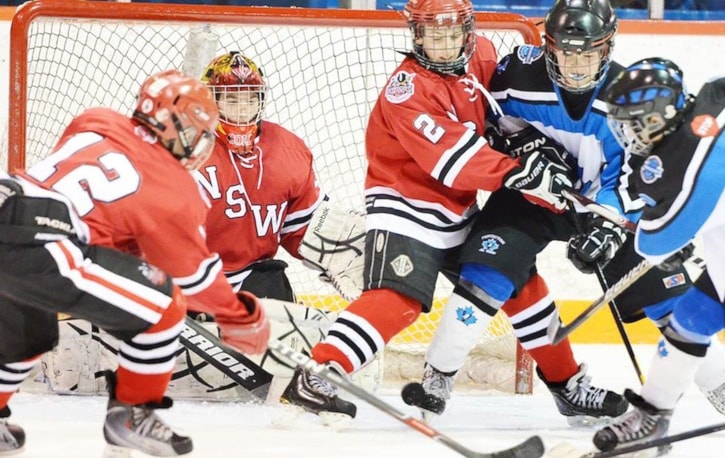Body checking has taken a hit.
Hockey Canada and its members across the country have decided to remove body checking from the peewee level for player safety.
The decision was made during Hockey Canada’s annual general meeting held in Charlottetown, Prince Edward Island last weekend. Rule 6.2b was approved to be modified to remove body checking in leagues governed by Hockey Canada starting in 2013/14. An addition was made to the rule.
“A work group has been directed to build a mandatory national checking and instructional resource program to support the progressive implementation of checking skills at the novice to peewee levels to better prepare players for body checking at the bantam and midget level,” said Hockey Canada's website.
Bruce Judd, president of Penticton Minor Hockey Association, said they are not against removing hitting from peewee hockey, but would like there to be more discussion by BC Hockey before it happens. B.C. Hockey is having its annual general meeting in Kamloops June 7 to 9. Judd wasn’t able to answer how many PMHA players have suffered concussions because they don’t have those numbers.
“It would be very, very low because otherwise you would hear about it,” he said. “I do know that we do get a record from the Okanagan Mainline Amateur Hockey Association. We get it if there is a problem with a kid having too many penalties and hitting from behind. They will send us a warning list.”
Judd said most of the incidents come from rec hockey, which doesn’t permit body checking.
“That bothers me,” he said of the contact in rec hockey. “It’s really left up to the association to try and monitor it. We’re only as good as what our referees are. If the referees aren’t calling it then we will never be able to solve the problem.”
During the 2011/12 season the Okanagan Hockey Academy had 132 players. Of those, 32 per cent, or 42 players suffered concussions.
Judd also said that BC Hockey or OMAHA are taking the stance that it will all fall in line with if they take two years of peewee and teach everybody how to hit down the road, then this problem is going to go away. He doesn’t share the same view.
“Associations don’t have the money to have an instructor just for hitting,” he said, adding that they have three small clinics at the start of the season.”We leave it up to the rec and rep coaches. Most of the coaches don’t know how to hit themselves. B.C. hockey should be paying for three or four supervisors to go to associations and teach the coaches.”
Judd holds the opinion that players should be learning how to body check starting in novice just like they would with skating and stick handling.
------------------------------------------------------------
------------------------------------------------------------
Dr. Carolyn A. Emery, of the University of Calgary, who conducted research on hockey injuries and concussions with several colleagues and wrote an article published by the American Medical Association, congratulated Hockey Canada on making “an evident informed decision.”
“I think this decision will save over 5,000 injuries, over 1,500 concussions in the next season alone in 11 and 12 year old players,” she said.
Emery and her colleagues performed studies during the 2007/08 season using peewee players allowed to hit in Alberta (74 teams, 1,108 players) compared to Quebec (74 teams, 1,046 players) where hitting isn’t permitted. The results showed that there were 241 injuries (78 concussions) reported in Alberta and 91 injuries (23 concussions) reported in Quebec.
“A follow up study in the past season where we compared Ontario to Alberta, where there is body checking in Alberta and no body checking in non elite levels of play in Ontario in the Greater Toronto Area, came to similar findings. A three-fold greater risk of injury and concussion in Alberta compared to Ontario in those non-elite levels.”
Emery’s research also showed that body checking was associated with 45 to 86 per cent of injuries among youth players.
“Concussion has been found to be the most common type of specific injury, accounting for more than 15 per cent of all injuries from nine to 16-year-old players,” states the report.
Emery said that she thinks body checking is a skill that’s needed in elite levels of play.
“It’s demonstrated in sort of the four stage development of that skill in Hockey Canada guidelines for development,” she said, in reference to positioning and angling, stick checks, body contact and body checking. “That’s all part of developing the skill of body checking. What we’re talking about here is not allowing body checking in games and the 11 and 12-year-old age group.”
Paul Carson, vice president of hockey development for Hockey Canada, was quoted on Hockey Canada’s website that when it comes to contact still being part of the game, they have educational programs and a mandate they were given by the board to have a national curriculum. All branches would be mandated to ensure that coaches are getting instruction in the checking game.
“The other part is the research,” said Carson. “Understanding that we need to continue to research how checking impacts on the game.”
Carson also talked about translating the knowledge once coaches are trained and helping youngsters develop. What kinds of practises are they doing.
“It’s important for people to know there are resources in place,” said Carson. “We’re just working towards a standardized process of delivery, of creating the resources that support coaches across the country.”
Emery plans to continue working on research and complete a historical cohort study in this coming year.
“We will actually be able to make comparisons in peewee within alberta where we have collected injury and concussion data,” she said. “Follow kids forward into older age groups. The side effects will be probably increase in participation in ice hockey which is a great thing.”
